#archieganda
Text
A Rough Moral Overview of Archie Comics: Teen Propaganda Machine
Part 2: The 40s and 50s: Dawn Of The CCA Era

In the 50s, Archie/PEP entered its first moralistic phase. By this point PEP was no longer the parent but the child brand, absorbed into Archie’s overwhelming mass and fame. PEP Comics: An Archie Magazine. The Comics Code Authority took effect in 1954, and Archie complied so readily with the new rules that the franchise would become synonymous with sugary-sweet, wholesome fare well into the next century. ("Wholesome” by the standards of the day, that is.) The banner above comes at the end of a story in which Archie helpfully explains Teen Age Hoodlums to his parents.
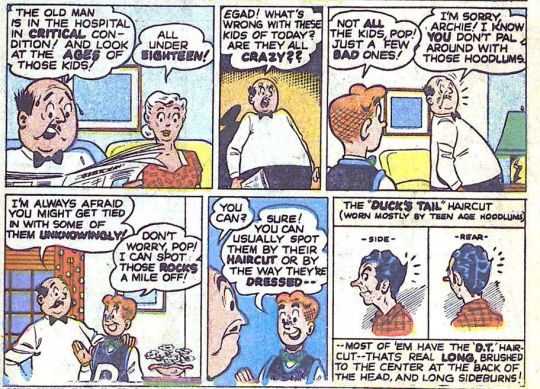

It’s a painfully hilarious/hilariously painful sequence, but notice that it offers reassurance to the teenage audience. Most teenagers are good and decent, Archie reassures us. Your parents may worry, with all the social unrest out there, but they understand you’re not like the bad seeds. Just stay on the strai(gh)t and narrow, and you’ll be all right. And don’t worry about your dad puffing cigar smoke in your face, that’s fine.
As a side note, corporal punishment wasn’t completely off the table at this point, but its use as a punchline was way down compared to the 1940s. There’s one story that hinges on Archie’s father spanking him so hard that his yells wind up as the backing track for a record that becomes a hit song with other teenagers. The story in question also jokes about the quality of teenage music and other pop culture, a testament to the fact that the writers and artists were very much of Mr. Andrews’ generation. But as a rule, Archie was now a good kid, and perhaps the reminder of overwhelming parental authority wasn’t playing as well with a teenage audience in the 50s.
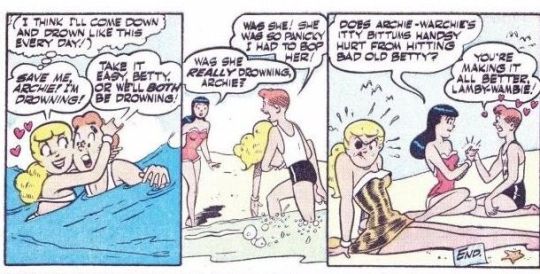
Violence towards the girls was also still on the table, though as in the early 40s it was usually couched in “for-their-own-good”. In fact, this is the exact same story as the one from that earlier story where both Betty and Veronica wind up with black eyes!
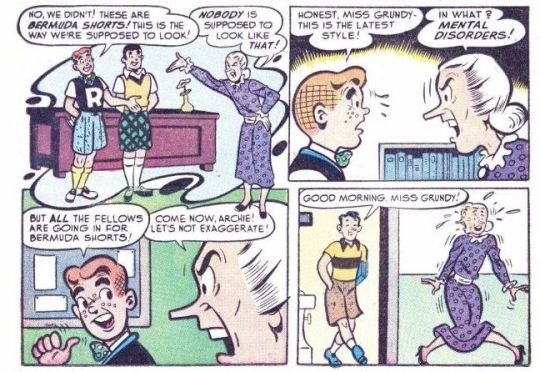
Teen fashion, music, and so on were all grist for the humor mill; sometimes the story validated the teens and sometimes the adults, but the generation gap was a key part of the humor. Mr. Weatherbee was as likely to be a viewpoint character as Mr. Andrews, and the perspective was usually the same. The kids were allowed to express dislike for their teachers (often Miss Grundy) in a way they couldn’t for their parents.
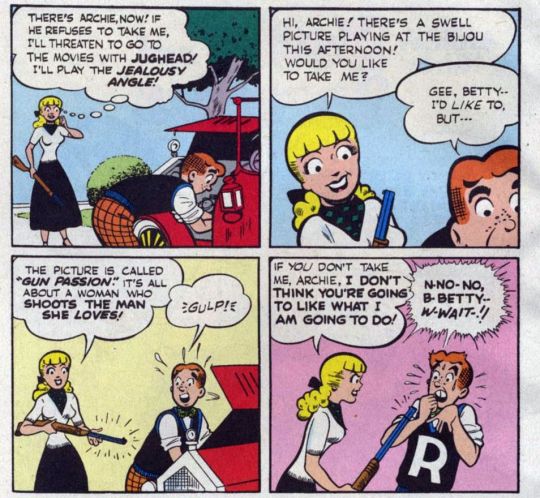

Betty during the later 40s started to be defined by a monomaniacal obsession with Archie, and in the 40s and early 50s before the Code took over, the results were sometimes very family-unfriendly. 40s/50s Betty is rarely, if ever, a genuine contender; Archie has eyes only for the glamorous Veronica, and while Betty and Veronica are nominally friends, moments of actual friendship are few and far between. Such is girlhood.
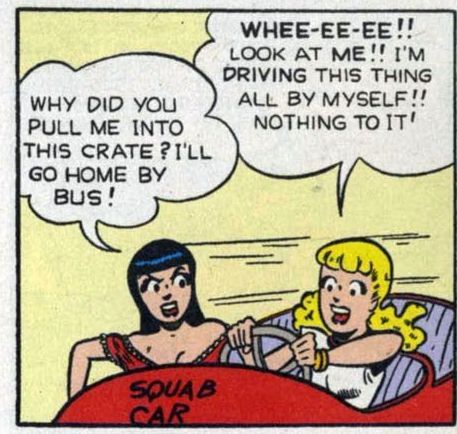
While characterization isn’t set in stone, sometimes Veronica is actually cast as the sensible one to Betty’s dizzy blonde, in a reversal of the dynamic most familiar to modern fans. Betty is honestly a lot of fun to watch during this stage of her development, but it’s hard to escape the inherent misogyny of the crazy dame obsessed with a boy who won’t give her the time of day.
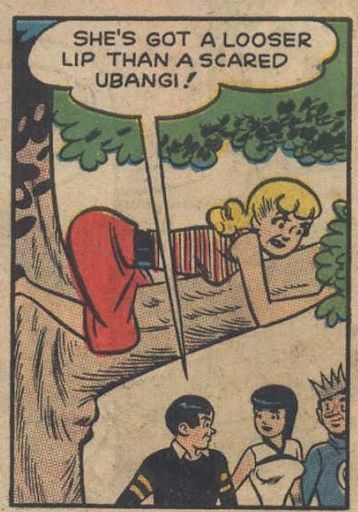
Onscreen racial caricatures of Black characters start to vanish during this time period, but this type of offhand reference crops up from time to time, and the stereotypical Romani “fortuneteller” would keep appearing for quite some time.
Jughead and Reggie both got their own titles in 1949; unlike the lengthy Jughead and Betty & Veronica titles, Reggie’s lasted only until 1954, and would be restarted sporadically over the years. Nonetheless, Reggie was firmly in the “frenemy” category now compared to his early appearances.
Also during the early 50s, Dan DeCarlo started working on stories for the various Archie titles, and he’d be responsible for tightening up the art style both now and during the 60s.

Sometimes it seems like the Code meant nothing at all. One story published with the CCA’s seal of approval has Archie and Reggie chasing after a Girl Scout in search of cookies. Betty and Veronica think they have more nefarious purposes in mind. What this means, of course, is that censorship standards at the time had no interest in protecting children from exposure to sex or violence, per se. Their purpose was to expose children to the kind of sex and violence deemed morally correct by a conservative governing body. Notice that despite the girls being ready to grab the boys and physically stop them, their tone in the first panel is only mildly scandalized. Corporal punishment of children and the aggressive, unrelenting pursuit of women of any age were the right kind of violence and sex, and it’s not by oversight that they appear so plentifully in Archie books under the Code. Their depiction in comics aimed at children was fully endorsed, and indeed necessary to instill the CCA’s values in generations to come.
8 notes
·
View notes
Text
A Rough Moral Overview of Archie Comics: Teen Propaganda Machine
Part 1: The 1940s
1941: Archie first appears in a small feature near the end of PEP Comics #22. His popularity builds rapidly, with the audience apparently writing in to express immense interest in the short monthly Archie comic.
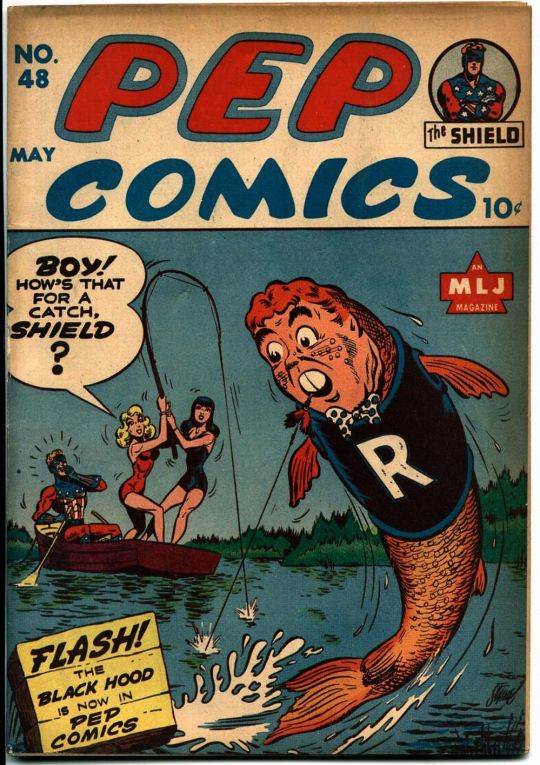
At first the Archie story isn’t even mentioned on the cover, but Archie himself slowly starts appearing on the cover, always with PEP’s big star at the time, The Shield. The Shield on the cover is at first much larger than Archie, but he shrinks over time, and after Veronica’s introduction, she and Betty start to feature on covers as well. The Shield continues shrinking...
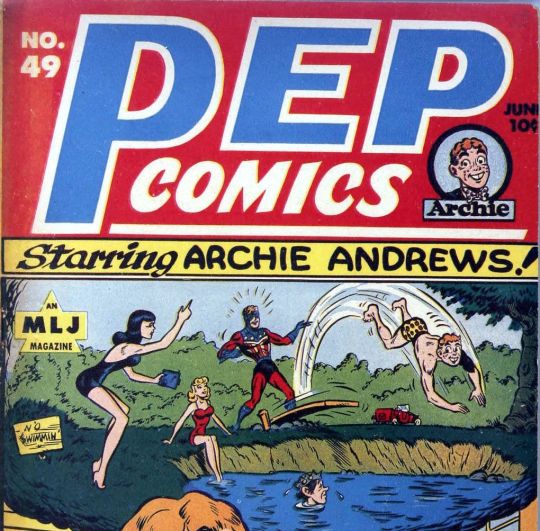
And by issue #49, the magazine is PEP Comics: Starring Archie Andrews! Archie quickly becomes its own imprint, and the only one of PEP’s lineup that survives into the present day. Ads in the magazine advertise an Archie radio show that was spurred by what was a apparently a massive outpouring of interest from PEP’s teenage subscribers. The concept of teenagerhood itself was a new invention dating from 1944. Archie’s reality included things like school, dating, and modern teen problems like trying to maintain a car and deal with wartime rationing.

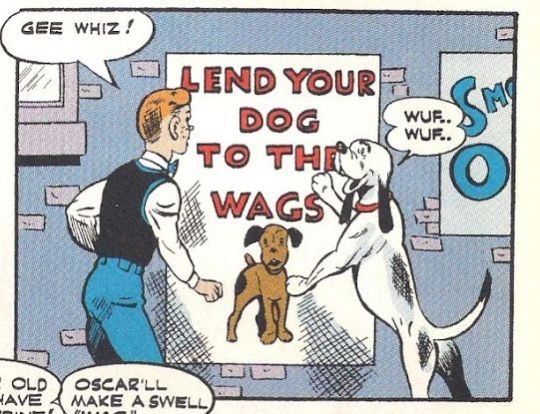
Also, sending your dog to fight Nazis. (Note: the above are two separate stories; no Nazis ever actually invaded Riverdale. Oscar, Archie’s dog, gave birth on at least two occasions, including during her army tour, and eventually faded from existence.)
At this stage, minstrel-style caricatures of black men appear on occasion in Riverdale (as train attendants and no-account bums who steal clothing out of the trash), and Yellow Peril-style caricatures of Japanese people are a regular fixture in other PEP features like “Captain Commando and the Boy Soldiers”. As a side note, Chinese people are depicted quite differently in Captain Commando. At this point in US history, they were seen as important potential allies in the war against the Japanese. In Captain Commando, they’re drawn like actual humans in comparison to Japanese soldiers. One story shows a Chinese warrior who’s been bamboozled by foolish Buddhist ideals of peace, but finally snaps out of it and gets his followers to join up with US forces in resisting Japanese occupiers. Chinese-Americans were depicted less frequently, but also running in PEP for a time was a rather remarkable depiction (for the time) of a Chinese-American hero: Fu Chang, International Detective. Chinese people would later be collapsed into the Yellow Peril phenomenon in US pop culture and there were some very racist depictions within Archie Comics, but in the 40s there was a different perspective on display for a while.
(Captain Commando and his Boy Soldiers have since lapsed into the public domain; evidently the heroic quality of child soldiers lost its gleam after WWII and reviving the property was never deemed profitable.)
Also in the 40s, many, many stories end with a quite literal punchline in which Archie gets taken out to the woodshed and beaten by his father for causing trouble. This was PEP’s light-hearted humorous fare that apparently spoke quite deeply to a teenage audience of this era. The depiction of corporal punishment is neither “pro” nor “anti”, it’s simply an unavoidable consequence handed down from on high. Archie’s misadventures lead inevitably to physical punishment from an authority figure, no matter how much or how little he’s to blame for things going wrong. Mr. Andrews himself is sometimes a figure of fun during this period, but the 40s and 50s are the time when he most often feels like a self-insert for the writers and artists, who would have been closer to his position in life than Archie’s.
Archie’s position, though, isn’t entirely as the object of abuse. It’s pretty safe to assume that the writers and artists also grew up with corporal punishment and can sympathize with the experience--though they’ve now entered the stage of life where they understand that it was done only for their own good. Archie at the end of these stories is both resentful and rueful; he wishes it hadn’t happened, but there’s no room in the pages of PEP to contemplate a world where it doesn’t have to.

Violence was much more accepted in the 40s, including against the girls themselves--for their own good, in this case, but it’s still jarring to see a man give Betty and Veronica black eyes. Their crime in this case was, of course, being so silly and man-crazy that they nearly drowned him and themselves.
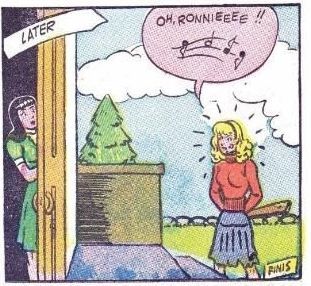

Often the violence was more cartoonish in nature, but it was only in the 40s that you’d see Betty showing up at Veronica’s door with Moe Szyslak’s weapon of choice.

The porter in this panel is one of the kindest portrayals of a black man in this period; the others (and the one depiction of a black woman that I noticed) are frankly unreproducible without heavy content warnings. Also in the 40s, fat and/or ugly women exist only as an object of fun or outright cruelty.

Vague “reducing plans” were advertised in the pages of Archie in the 1940s. This particular method was, as the name suggests, seaweed pills that were also marketed as chewing gum.
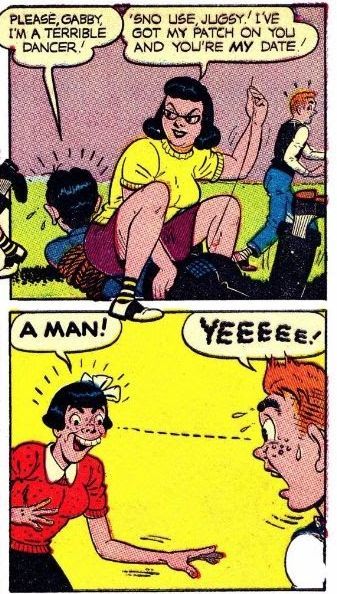
You may notice in some stories that the “ugly” and undesirable woman has very nearly the same face as Archie himself; the irony here is very likely unintentional. It’s rarely (seriously) suggested that there’s anything morally wrong with Archie aspiring to a girl much prettier than he is, but an ugly girl expressing interest in any boy is a figure of fun right up into... well, the present day. The Gabby pictured in the panel above her was a semi-recurring character, one of the only plus-size recurring characters ever depicted in Archie. As her name suggests, she was a gossip and one of the undesirable girls, but she was sometimes allowed to be friendly with Veronica or Betty without immediate karmic punishment. She’s also notable because she’s not only one of the only plus-size characters, she’s one of the very few plus-size female or teenage characters. Mr. Andrews, Mr. Weatherbee and Pop Tate all survived the 40s, but Gabby didn’t.
Betty at the inception of “Archie” (the comic) was just Girl. She rather liked Archie and he liked her, and he would try to impress/date her but end up having his monthly funny adventure. But only once Veronica was introduced did she start to gain more dimension, this time as Other Girl. Veronica was rather nice to begin with and it took a short while for them to start getting played off each other as “characters”. There was still little difference. Veronica was always rich and as a result became snooty fairly quickly, but her flaws were the flaws of an object. They existed to create difficulties for Archie, in his struggle to impress her, and Betty was differentiated only by not being snooty.


When Betty and Veronica were allies, it was because Archie had blown it somehow, and they were naturally compelled to be allies by virtue of both being girls. (When they didn’t like each other, it was also because they were both girls, and such was the natural state of being girls.) The panel above--both in the same pose, their identical faces lifted in scorn towards all men--would be echoed in other later stories, whether by chance or by accident.


Their posing in the 40s was frankly pretty ludicrous and transparent in its intentions.

Sexual attraction wasn’t explicitly commented on in the 40s comics in the way we understand “explicit” today, but it’s allowed to exist more openly than in later years. The va-va-voom effect highlighting the breasts would have to become more euphemistic as the decades passed.

In general, there was very little pretense in the 40s.

Artists had no qualms about showing the girls nearly in the nude (I cropped out a panel of Veronica in the bath above), nor about showing adult men leering at them. Even Mr. Weatherbee was occasionally moved by their charms. Generally adult men were “punished” for showing visible attraction, but only in humorous ways. It was more common for the teenage boys to drool over the girls, but the only disapproval shown when grown men did it came from women their own age, playing the role of scold or prudish spinster. There was also the occasional gag in which an adult man was misunderstood as a “masher” or peeper and received undeserved punishment from the supposed target.
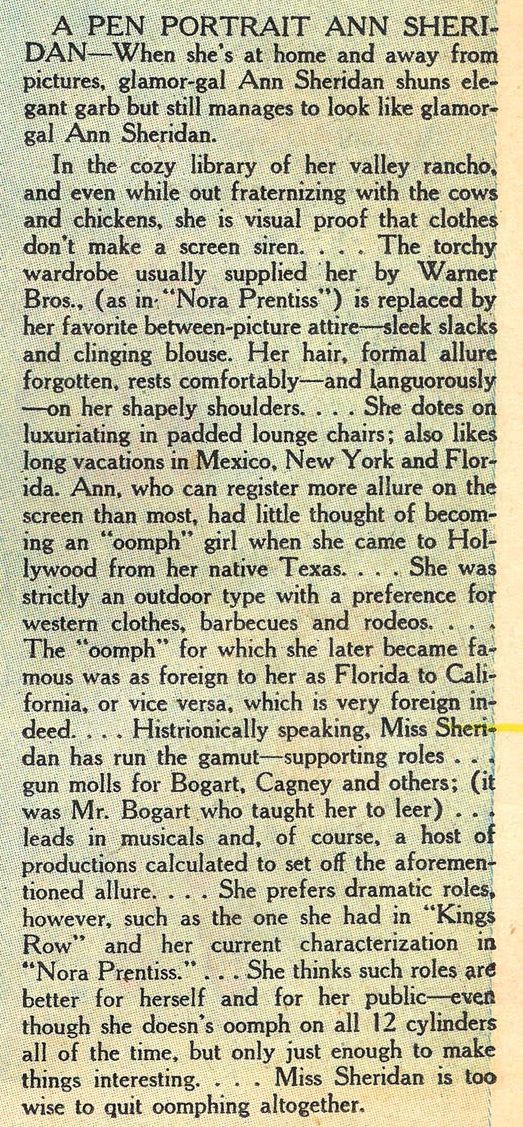

There were various write-ups of celebrity activity in the 40s and 50s, and there too the attitudes towards women were pretty much what you’d expect, but even in the late 1940s the realities of life were not entirely veiled from teenage eyes. There was room for what would now be considered adult jokes.

Also in the 40s, Archie cross-dressed, like, a lot, in a way that noticeably vanished once the 50s rolls around. It’s always as a gag, and it’s usually noted that he makes an ugly girl, but in this era it seems to have been an idea that could be poked fun at without threatening the moral fiber of all America by the mere suggestion.

In fact, one semi-famous 1948 story, “The Battle of the Jitterbugs” (reproduced more fully elsewhere) revolves entirely around the girls and the boys competing in a “fair contest’ to see which sex is better at dancing--since boys only lead and girls only follow, it’s impossible to determine who can dance better overall. The obvious solution is for two girls to dance with each other and two boys to dance with each other.

Crucially, the idea is suggested by Reggie, the prankster of the group, framing it as a joke from its inception. Archie, the main character, follows through with it as a means of asserting male superiority. There’s also no possibility that two boys could dance, or two girls could dance, without the conceit of one performing the role of the opposite gender. But in practice, the whole thing does involve a lengthy depiction of two boys dancing together, and indeed, jokingly flirting with each other.


Again, the joke-flirting comes in the form of mocking from Reggie, both en femme and en homme. Archie, the protagonist and everyman, is uncomfortable throughout and finally throws Reggie right out Pop Tate’s door after Reggie goes too far in impugning his masculinity.
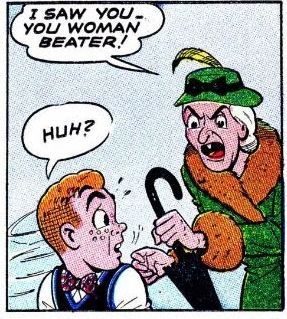

At this stage, the usual band of crones step in to punish him for imagined crimes against women, and he finishes the story sitting in bed with a broken leg, making a pronouncement that stands out rather sharply to the modern eye: “Confidentially, Jug! I’m no longer interested in women... or dancing!”

Veronica and Betty are significantly more comfortable with each other. In fact, it’s a rare 1940s story where they don’t quarrel with each other at all! Veronica’s femininity is seemingly unthreatened by the hat and pants, even though Archie Comics would continue issuing dire warnings against women in pants up through the mid-1970s.


It’s hard to imagine they lost after this! The tone of this page is downright celebratory, a rare occasion of early Betty and Veronica working together and coming out the victors of the story, not by one of them winning Archie, but by both of them showing their own skill at something without trying to show the other up. “Battle of the Jitterbugs” is a true rarity in these early years, a depiction of female triumph that doesn’t exactly defy the era’s pop culture as a whole--women were creating their own art even in the 1940s--but it does defy nearly every other Archie story up to the mid-1970s.
#archie comics#archieganda#i couldn't possibly put enough content warnings on this#content warning just about everything
8 notes
·
View notes
Text
A Rough Moral Overview of Archie Comics: Teen Propaganda Machine
Part 5: Al Hartley Rears His Ugly Head
And then... there's the grim shadow of Al Hartley and his Christian Archie comics.
In any discussion of the politics of Archie Comics, Al Hartley stands in a class of his own. If you know much about Archie Comics, and even if you don't, you may have seen some of his work, because by modern standards--oh boy, do those Spire Christian Comics make an impact. They're officially licensed, all of them, and some are reworked from stories he wrote under the official Archie banner, often stories that were already groaning from the strain of not mentioning Jesus.



The "Christmas spirit" was sometimes used as a stand-in. In the Spire Archie comics, the characters are allowed to preach openly.
Usually Betty. Dear God, Al Hartley's Betty. But one interesting thing is that Ethel and Dilton, of all people, are usually the runners-up in Jesus loving. Apparently the Evangelical split with science hadn't taken effect yet, because Hartley-Dilton is an ally to religion, and his cleverness only brings him closer to God. Hartley's Ethel is, bizarrely, an incredibly sympathetic take on the character, perhaps one of the kindest ever looks at a girl so desperate for acknowledgment, validation, anything, that she's willing to put up with Jughead.
Except for the comic where she talks about how her parents neglect her, and Archie and Betty explain to her that God wants her to honor and respect the parents He chose to give her, no matter what they do. That's kind of a slap in the face.
Ethel is either the innocent in pain, ripe for conversion, or a zealous convert. Archie often takes her place as the clueless wandering fool. Reggie, Jughead and Veronica are sometimes converted at the end. Sometimes Veronica is the worldly, promiscuous no we can't go quite that far, but that's the suggestion. Reggie and Jughead also slot very well into an exhibition of humanity's sins, with Reggie of course being vanity and Jughead gluttony. Usually Jughead's gluttony is a forgivable sin, but one in need of fixing nonetheless.

KRAK! This mansion, owned and operated by one "Professor Beelzebub", represents, of course, Sin in all its forms, and Jughead is swallowed up early on by a room full of food. Betty approaches Archie, from outside the house, and manages to free him with the power of prayer.
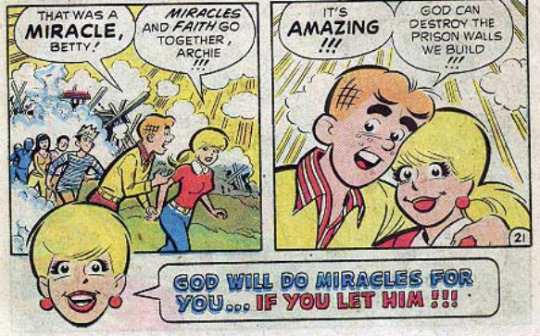
Notice the sinful masses crawling from the wreckage almost as an afterthought. Can you guess who Hartley's favorite character is?

Yes. Al Hartley was just a little partial to Betty. Hartley was supposedly born again after tiring of the cheesecake work he produced for the first part of his professional life, but he managed to be astonishingly horny for Betty despite that. And his writing is responsible for Insufferable Christian Betty, AKA the worst Betty.

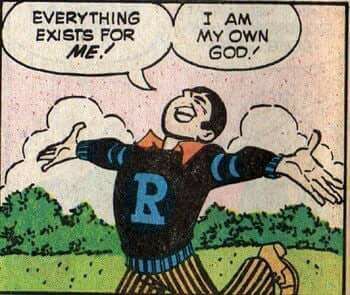

Hartley's comics are.... not subtle. They're Archie at the height of camp and the height of hilarity...
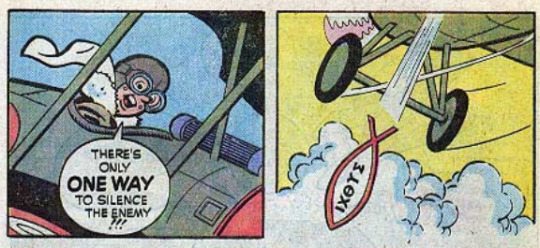



....and they're hateful, reactionary trash covered in a sugary Archie coating. A Sugar, Sugar coating, if you will.
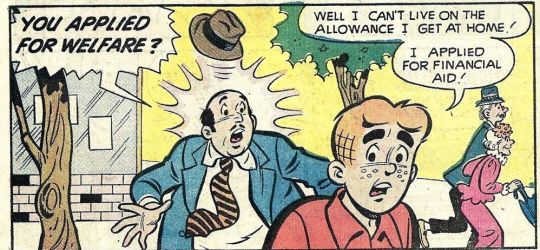
Even in his "official" work for Archie Comics, you can smell the conservative right through the page.


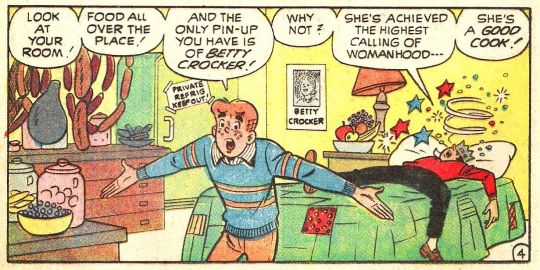
One recurring theme is that Jughead's love of food and disinterest in girls are not two separate traits, but rather one single pathological obsession with food that causes him to eat because he isn't dating.
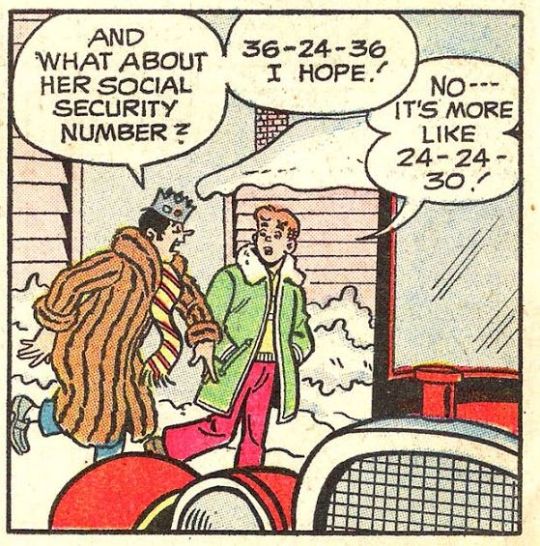

That, of course, is a problem to be fixed. Jughead Jones sits around thinking about how 36-24-36 girls are the best type of girl???? Really, Mr. Hartley???


And forget what I said about sympathetic portrayals of Ethel. This is how she gets her happy ending. As a hot dog.

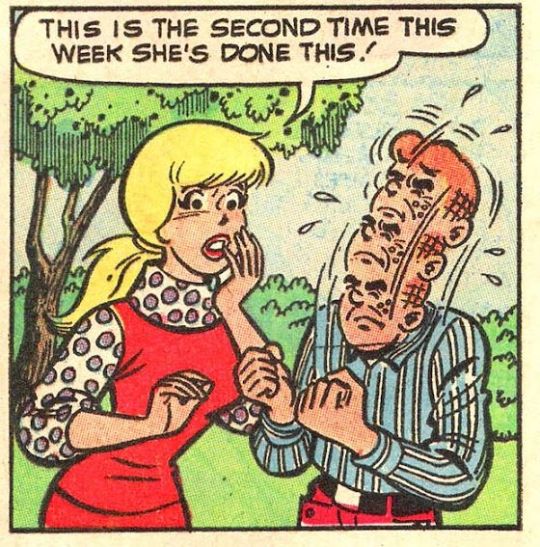
Hartley's reign of terror actually started in the 60s, but by the 70s his art (and often writing) have become immediately distinguishable. The tells are in the girls' eyes (Betty's especially) and in Jughead's nose, which under Hartley's pencil starts to shrink near his face.

Oh, and this face thing, and the triple punctuation marks.

This is a typical set of Hartley panels showcasing all his trademarks except Jughead's nose.

And the fact that his Reggie never stops making this face.

His official Archie work, while slightly restrained, still shows an inherent worship of authority (A sixteen year old girl looking at her principal and thinking she feels sorry for “that cute man”??????? What????)
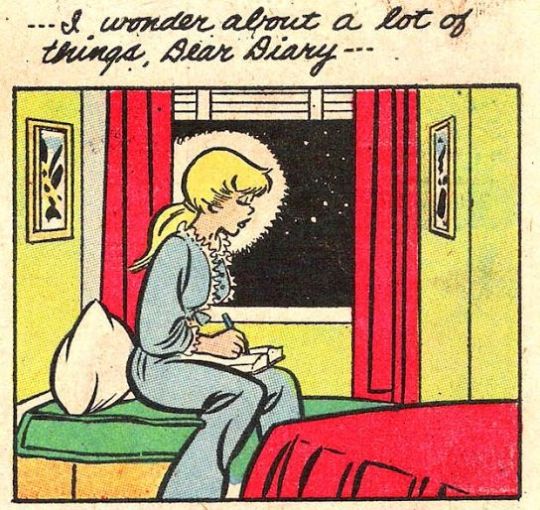
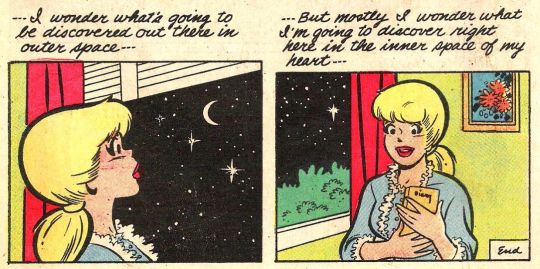
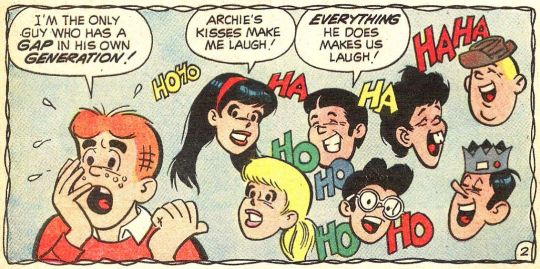
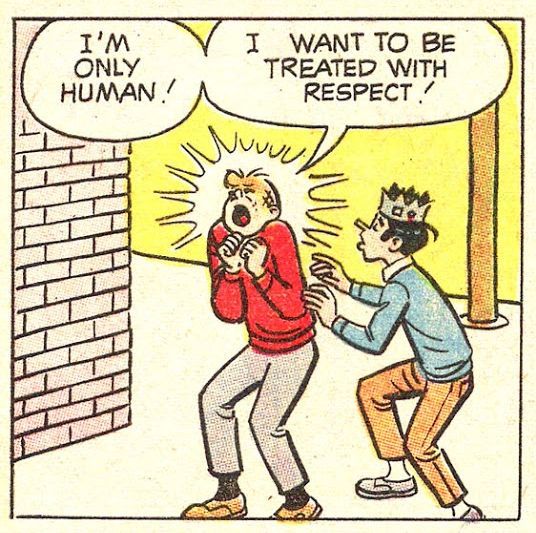

....and a sense of emptiness within the characters, waiting to be filled by... something.


His openly Jesus-y comics would revisit this theme, over and over again.

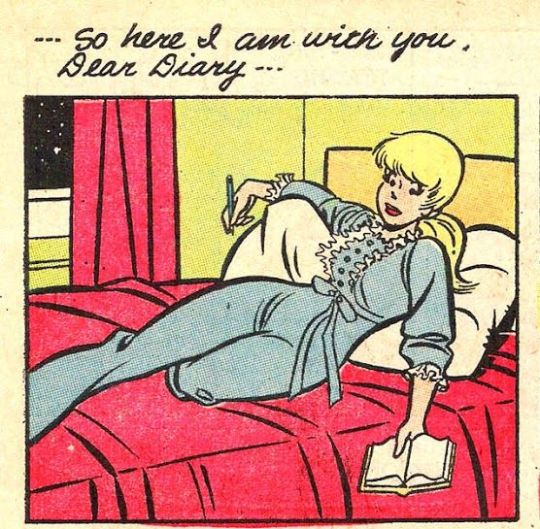
And one wonders if he was really as burned out on cheesecake as he claimed.

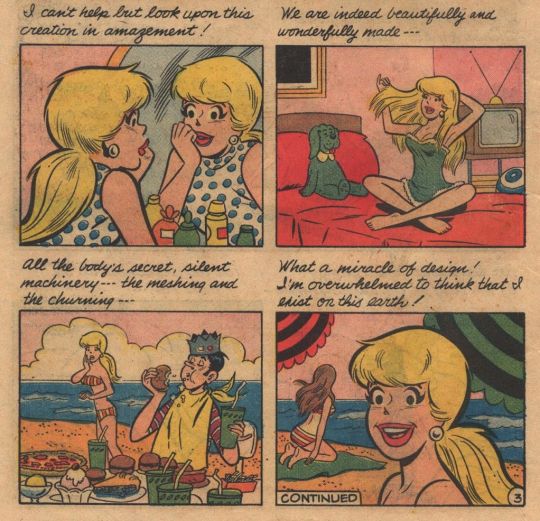
Yeah, he was barely holding himself back in a few different ways.



(These are three different stories taking place on the beach where the Archie characters spend about half their natural life cycle. The last one has no writer credited anywhere, but they’re Hartley’s pencils and the themes are quite similar to his two confirmed “Veronica being a bitch to Archie at the beach” stories.)
A couple of Hartley stories stand out in a very weird way: his Veronica isn't just spoiled and domineering, she hardly even wants Archie to start with. And in these stories, Archie's interest in Veronica is paper-thin, held together only by the main conceit of the love triangle and the fact that man is born to sin. One senses a touch of the aggrieved self-shipper at work, and more often than not it comes at the expense of humor. Other writers and artists had fun with a mean Veronica; Al Hartley just wants her sinful ass to stop getting in his best girl Betty's way.
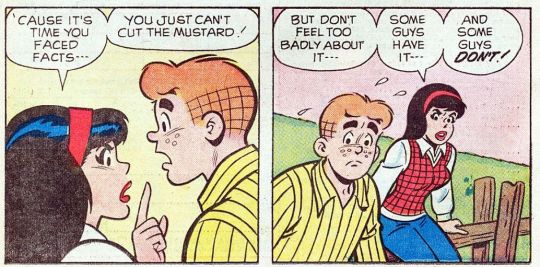
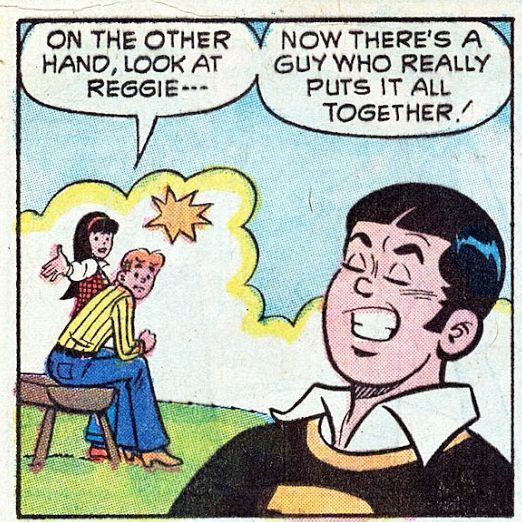
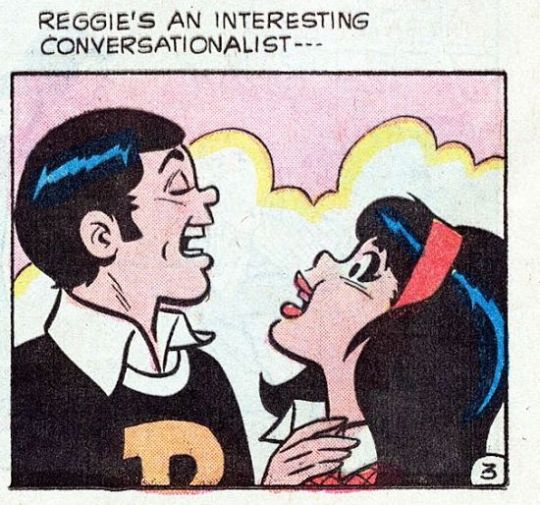
Boy, does he want her gone. She and Reggie often end up together in the Spire stories, in defiance of the prevailing canon since at least the 50s, which is that that Veronica’s willing to date Reggie if Archie doesn’t show up or blows it, but for whatever reason, Archie is her primary interest. She doesn’t like Reggie for his personality in any story where Reggie’s personality actually figures beyond “other boy”. Yet Hartley sees them as the snooty secondary couple, brought together by their love of vanity and other sins, and the fact that Betty must be Archie’s final choice at all costs.
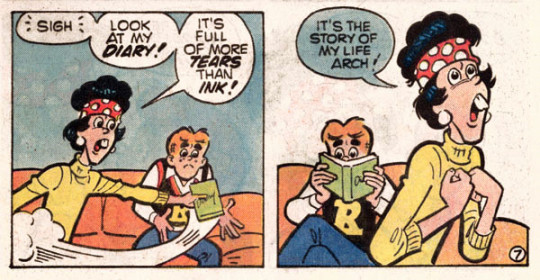
At their best, Hartley’s stories touch on realistic insecurities and add a little human dimension to characters like Ethel and Betty.

At their worst, they remind you exactly how cynical those additions are. Hartley has no compunctions about mocking Ethel if that’s what the story needs. "That fellow just offered two cows for Big Ethel!" Betty cries, in the middle of a band/missionary performance by The Archies in India. "That's the best offer we ever had for Big Ethel!" Jughead laughs, as Ethel (on triangle, because of course) looks distressed in the corner. Archie tells Jughead not to joke, because the man is serious! Hartley Triple Exclamation Points!!!
These insecure characters could be anyone at all, because the only reason they show these insecurities is so Al Hartley can sell you, the reader, on fixing your own insecurities with his brand of Jesus. In his non-Archie comics, they’re replaced seamlessly with non-characters, and the only result is that it's less funny.
And of course, don’t forget: just because Al Hartley only draws white people in these Spire Christian Comics, that doesn’t mean there’s any kind of racism going on in good old Riverdale.

4 notes
·
View notes
Photo

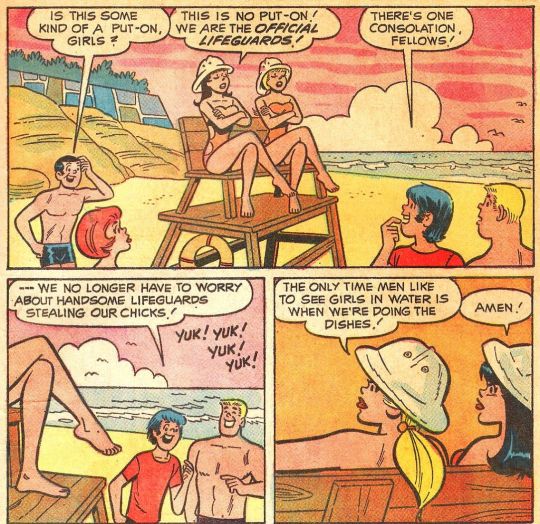
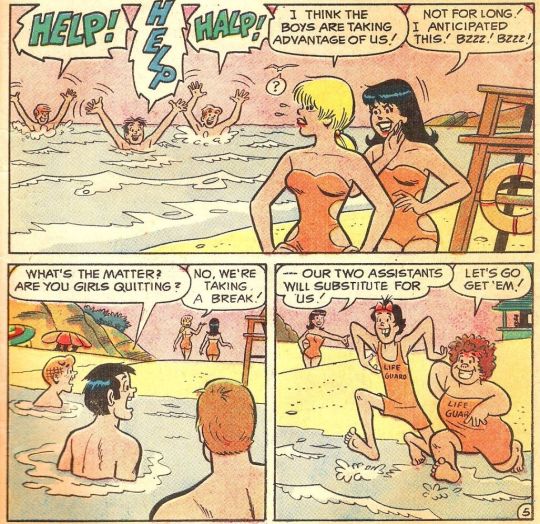
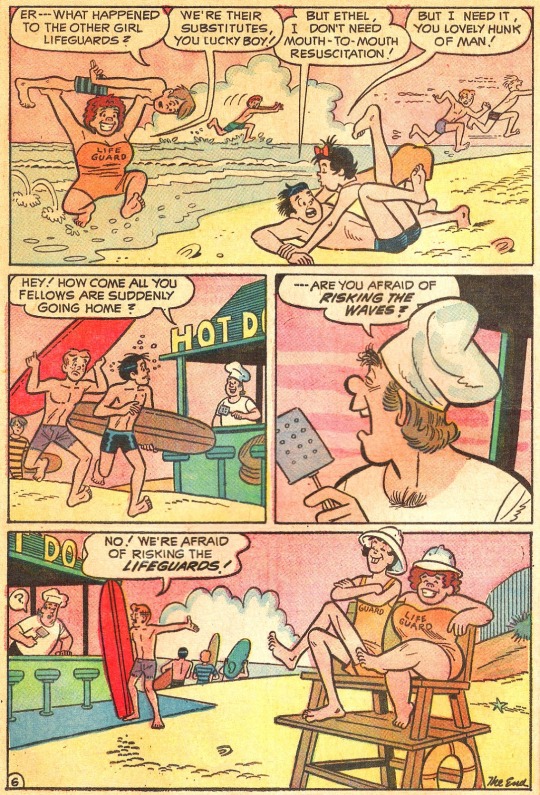
1971 archie comics issuing a brave call for equal rights as long as you’re not a gross uggo or anything
3 notes
·
View notes
Text
Rough Moral Overview of Archie Comics: Teen Propaganda Machine
Part 3: The Late 50s-Early 70s: Glory Days (In Certain Ways)
In the late 1950s, Dan DeCarlo and Frank Doyle took nearly full control of the “Archie style”, and while Archie had been a media institution for at least 15 years at this point, it’s here that it really earned its place in the pantheon of American comics. The dialogue and paneling are not only readable by modern standards, they’re still riveting. You could take any random panel from the Doyle and DeCarlo team at their peak and it would be absolutely striking.
It’s also during this time that Archie Comics is at its most horny. The Comics Code Authority was still very much in effect, and Archie was one of the most notable comic franchises that played its compliance to the hilt. Yet in Doyle and DeCarlo’s hands, Archie’s Girls Betty & Veronica is a cheesecake fest that tests the limit of the PG rating. They mastered the use of euphemism, talking about “figures” and “frames” to a degree where it ceases to be subtext.

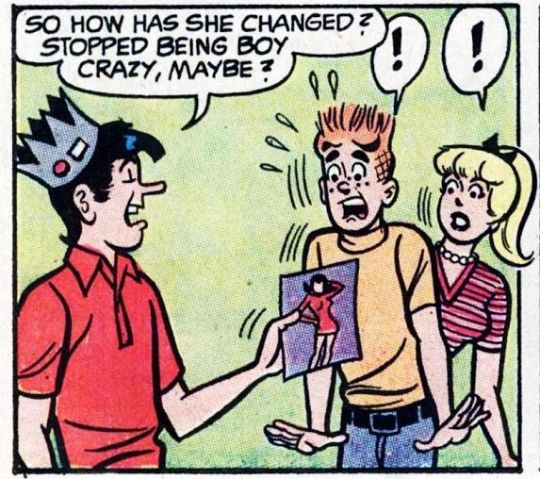
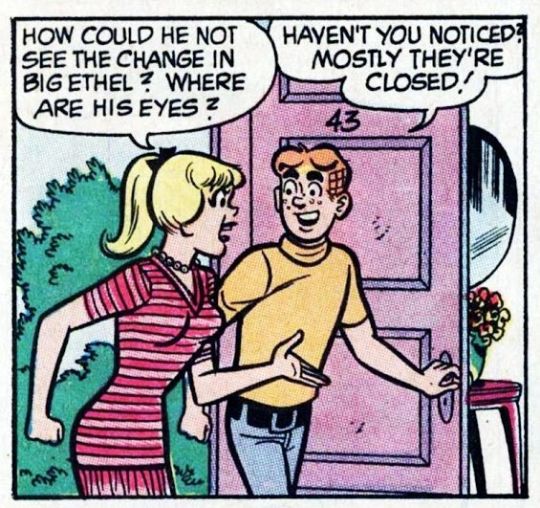
In a Betty and Me story called “Negative Reaction”, Archie and Betty put Ethel’s head on a photo of Betty’s body. The dialogue goes no further than “the change”, but there’s no mistaking what that change is. Writers and artists weren’t credited yet, and the story’s author is unlisted online, but Al Hartley, a future big player for AC & co, is listed on pencils. Here his art is clearly aping DeCarlo’s house style, but it would later change into a more distinctive one, and he did his most notable work for Archie on Betty and Me.
There’s no question in the 60s that the primary purpose of a girl is to be looked at by boys. Jughead is allowed a free rein in his open misogyny that wouldn’t be revoked until the 1980s, and the only rebuttal Archie and Reggie offer to his hatred of women is that actually, women are pretty sexy. Betty and Veronica are not permitted to argue in their own favor. Nor have they any real interest in doing so. Jughead’s open disdain for them, and their intelligence, and their right to exist within 20 feet of him, doesn’t make anyone uncomfortable--no one who matters, anyway. They can prove their worth by putting on a swimsuit and making Archie’s eyes bug out. And if Jughead really crosses the line, it can be solved by forcing him to accept romantic attention he doesn’t want.
In general, Veronica is still Archie’s preferred girl in the 60s, but there’s no absolute consistency across all the titles--Betty does much better for herself in Betty & Me than she does in Betty & Veronica, for example. Veronica was starting to become outright evil, while Betty toned down the maniacal Archie obsession and became more of the “good girl”, although it would be a while before the comics reached the height of the moralistic Betty vs. Veronica battle in the 70s.
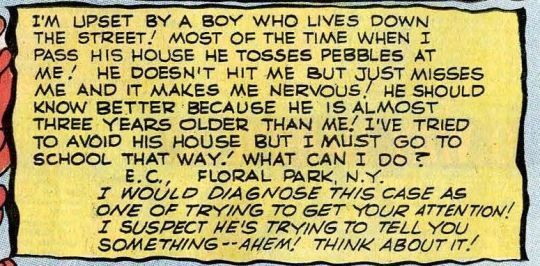

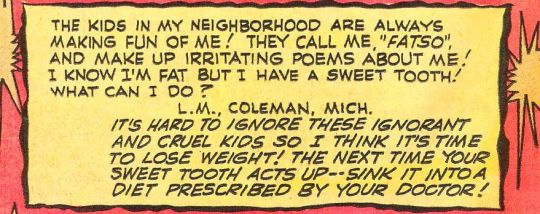
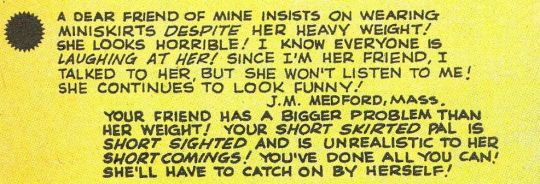
The advice dispensed during this period is almost more revealing than the stories themselves. Truly grim stuff. By the 90s, the “dieting” storylines would at least take on a veneer of being more focused on healthy exercise, but even in the 80s, one very telling answer advises, “Anyone who is overweight is not too young to go on a diet!”

But on the bright side, apparently Mr. Cooper dated a Jewish girl briefly, so it’s not all bad in Riverdale! She was the Veronica of their generation, even!

Issue 30 of Betty & Me (1970) also features everybody’s favorite classic character, Billy Boston, who seems to have vanished from the world after this story but does represent a step forward for the Archieverse, just a short, um... 16 years after the generally accepted start of the civil rights movement. There’s a very visible attempt at this time to start including Black background characters.
But since Chuck appears more in the boys’ titles, the most prominent Black character in the Betty-related titles is actually Valerie of Josie and the Pussycats, who appears regularly in ads for delicious flaky Hostess Twinkies and snack cakes, bonding with Josie about how much they apparently hate their dumb annoying friend Melody.
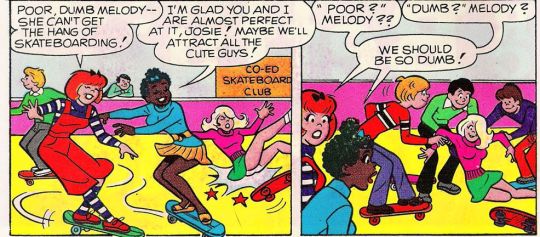


You’ll notice that she’s allowed to encourage Josie to seek attention from white boys, but not to directly seek that out herself, and no Black boys appear in the ever-present male crowds, because that might suggest the possibility that one of them could be attracted to Melody or Josie. Dwayne McDuffie spoke about interracial dating being absolutely forbidden by Archie Comics back in 1992. It was only in 2010 that Valerie was finally allowed to kiss Archie in the pages of his self-titled magazine.
In a mid-60s story, Mr. Weatherbee cheerfully assures reporter Betty that there are no unpleasant things in Riverdale like riots, unrest, or, uh, sit-ins. If there were no sit-ins in 1960s Riverdale, it was probably only because the town didn’t have enough Black people to make up a quorum.
And in 1965, Betty and Veronica #109 published a story titled “Sayonara” which would seem to be unprintable by modern standards. You can in fact buy the issue as an ebook, and in 1977 they republished it in Archie Comics Digest. Bill Yoshida (sometimes credited as Saburo or Saburo Yoshida), probably the company’s most prominent letterer, joined up with Archie in the same year, 1965. It’s not clear whether he had to work on "Sayonara”.
3 notes
·
View notes
Photo

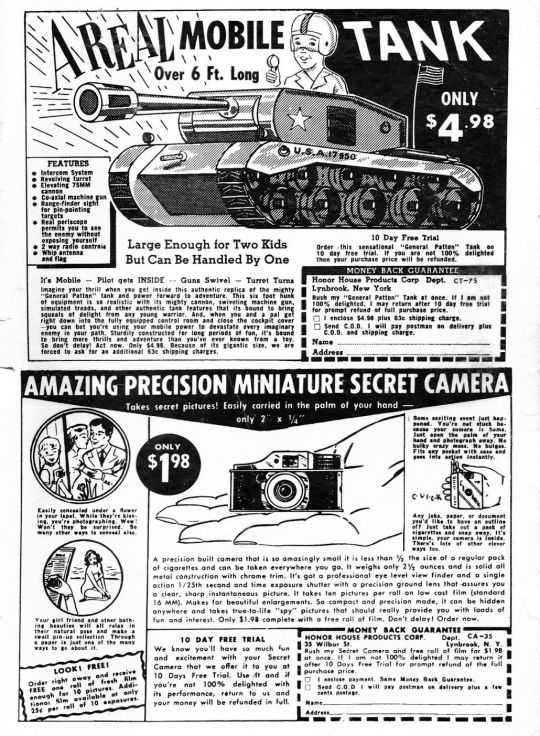
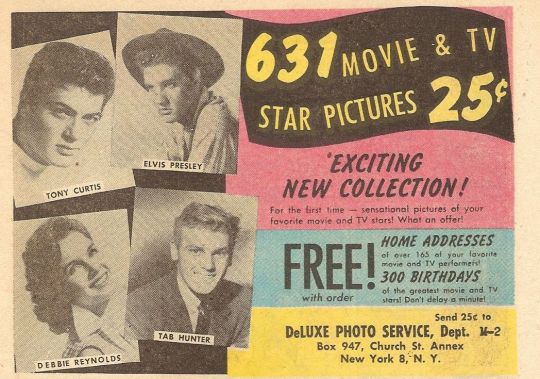
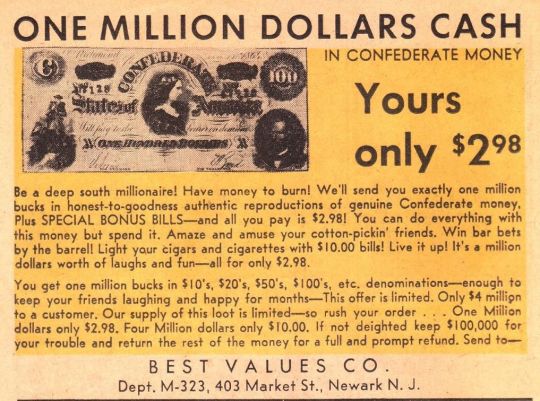

Trying to maintain a record of criminal activity endorsed by ARCHIE COMICS in the 1950s. so far:
- animal trafficking (FOR THE CONCERNED: this turned out to be a fraudulent advertisement and the conspirators were busted by the FTC in 1960. There’s no evidence of any monkeys actually being distributed)
- armed insurrection
- covert surveillance for sexual and other purposes
- stalking (good luck with Tab Hunter’s home address, ladies!)
- forgery/distribution of Confederate currency
- breaking and entering, assault and battery via electric shock, cheating at gambling (for amusement purposes)
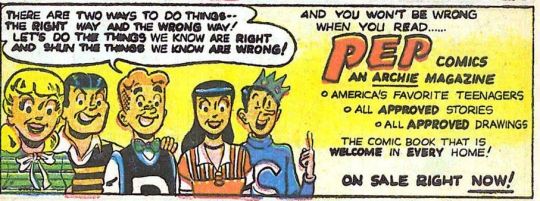
Remember: Archie Comics are APPROVED BY THE COMICS CODE AUTHORITY!
#trying to hook teenage girls up with elvis presley ought to be considered a crime in its own right#google it!#he was terrible!#archieganda#archie comics
0 notes